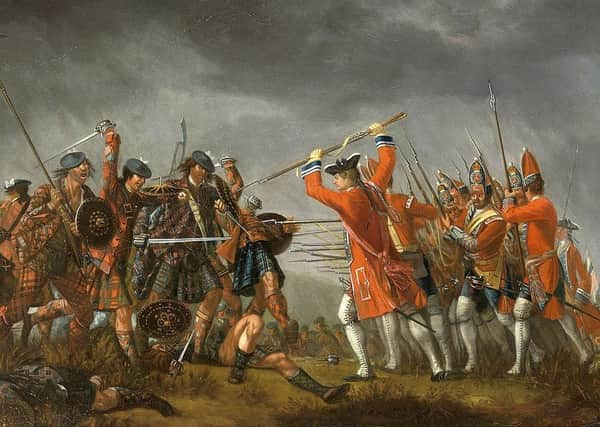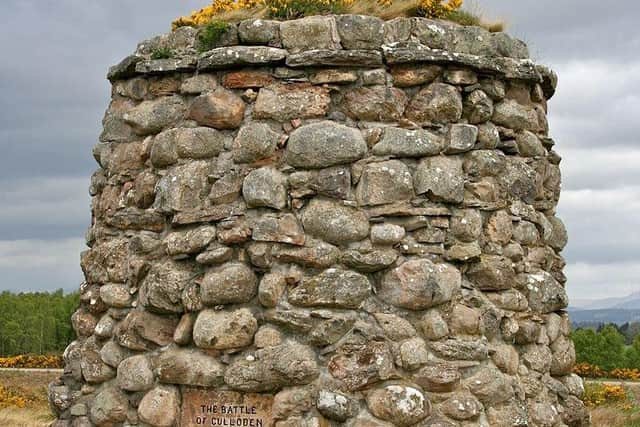Culloden: Last great (but one-sided) battle fought on soil of the mainland


On December 7, 1745 Charles Edward Stuart’s bedraggled army embarked on their long retreat from Derby, heading north and crossing into Scotland on December 20.
On January 17, 1746 the Jacobites won a tactical victory in heavy snow and failing light at Falkirk Muir, near Stirling.
Advertisement
Hide AdAdvertisement
Hide AdCharles’ half-starved followers were pursued by William Augustus, Duke of Cumberland, the third son of George II, north of the border. Eventually, on April 16, 1746 Cumberland and Charles confronted each other at Culloden moor, six miles east of Inverness.


There was a huge disparity between the two armies in terms of size and quality. The Duke of Cumberland had an army of 6,400 foot, 2,400 cavalry and 800 dragoons and an artillery train of 10 three-pounder guns and six mortars.
Charles’ army consisted of less than 5,000 exhausted and hungry men. His force was ill-equipped, had only limited artillery and very little by way of cavalry. The quality of the Jacobite leadership was fairly mediocre.
Jacobites’ choice of battleground proved catastrophic. Lord George Murray, the most gifted of the Jacobite commanders, subsequently wrote that there could never have been ‘more improper ground for Highlanders’ but Charles preferred to take the advice of John William O’Sullivan, one of ‘the Seven Men of Moidart’, a sycophant and an idiot to boot,than listen to the hard-headed appraisal of military experience. The moor’s flat expanse and open space suited Cumberland’s cannon and cavalry perfectly. To the south of the River Nairn there was broken, hilly ground which would have been better suited to the wild and ferocious onslaught known as the ‘Highland charge’, the Highlanders’ sole modus operandi.
Advertisement
Hide AdAdvertisement
Hide AdThe battle lasted no more than 40 minutes. The outcome was perfectly predictable. The casualties demonstrate what a brutally one-sided affair it was: perhaps 300 government troops killed and wounded and between 1,500 and 2,000 Jacobites.
The real horror came afterwards. Cumberland’s dragoons slaughtered fleeing clansmen and innocent bystanders indiscriminately. On the battlefield while surgeons tended the government wounded, redcoats, closely observed by their officers, bayonetted or clubbed to death the Jacobite wounded.
Cumberland is said to have asked Charles Fraser, the severely wounded commander of the Fraser contingent, to which side he belonged, and on being told ‘to the Prince’, turned to Major James Wolfe, one of his aides, and ordered him to kill ‘the insolent rebel’. Wolfe refused, indicating that he would rather resign his commission. James Wolfe’s popularity in Canada among the Highlanders of his army, and especially among the Frasers, stemmed from this incident.
Culloden was the last great battle fought on the soil of the mainland. One might suppose that it was the climax of a struggle between the Scots and English but it was not. Nor was it even a struggle between Highlanders and Lowlanders.
Advertisement
Hide AdAdvertisement
Hide AdWhile the prince’s army was predominantly Highland in composition, it was not exclusively so. Not all the clans rallied to the Young Pretender and the Jacobite cause. If they had ‘Bonnie Prince Charlie’ would have had a much larger army at his disposal. The complexity of clan politics and religion helped shape allegiance.
In general terms the Jacobite cause enjoyed the support of the Roman Catholic clans and the Episcopalians of the North East. The staunchly Presbyterian Campbells supported the Hanoverian succession and served in Cumberland’s army.
Some clansmen only fought because their chieftains’ word was law and the penalty for disobedience was a blazing homestead.
Other clansmen – notably the Grants and MacLeods – disregarded the preference of their clan chieftain.
Advertisement
Hide AdAdvertisement
Hide AdThe events of 1745 and 1746 amount to civil war. Father and son and brothers found themselves on opposing sides, not necessarily for ideological reasons. For some this was a product of calculation: no matter who won, family lands would not be lost.
During the retreat northwards the Jacobite army at Stirling was augmented by a force of 400 Mackintoshes, raised by Lady Mackintosh (née Farquharson), wife of the clan chief (the wife of a clan chief was automatically accorded the title ‘Lady’), but her husband was on the side of the government.
Cumberland returned to London in triumph. Handel composed ‘See the Conquering Hero comes’ to welcome him and the flower ‘Sweet William’ was named after him. Although in Scotland he has a weed named after him, more significantly he received the Freedom of Glasgow and Edinburgh, both loyal to the Hanoverian succession, and the thanks of the Church of Scotland.
Culloden was the only battle Cumberland ever won. His dismal record of military failure against the French in the War of Austrian Succession and Seven years’ War led to his estrangement from his father. History tends to remember him as ‘Butcher Cumberland’.
Advertisement
Hide AdAdvertisement
Hide AdTradition and folklore surely have been much kinder to the prince than he deserves. After the battle he advised each man should save himself as best he could. Was this not abandoning his followers to save his own skin?
Yet his five months as a fugitive in the western Highlands and Islands with Cumberland’s men hard on his heels, not least his eventual escape to France with the selfless assistance of Flora MacDonald, has been transformed into the stuff of song, legend and the décor of tins of shortbread.
Although Charles Edward never returned to Scotland, he did pay a fleeting and clandestine visit to London in 1750 to convert (briefly) to Anglicanism.
Culturally, there was little, if anything, Scottish about the prince. His father was half Italian. Maria Clementina Sobieska, his mother, was Polish. Charles Edward Louis John Casimir Sylvester Severino Maria Stuart, his name in full, conveys his rich and varied European heritage.
Advertisement
Hide AdAdvertisement
Hide AdJust as James II cared little for the Irish at the end of the 17th century, the Scots did not count for much in the prince’s calculations. Restoration to the English throne was always the real focus of the ambition of the House of Stuart.
Forty-two years after Culloden, Charles Edward died, a drunken and dissolute wreck and anything but a romantic figure, in Rome.